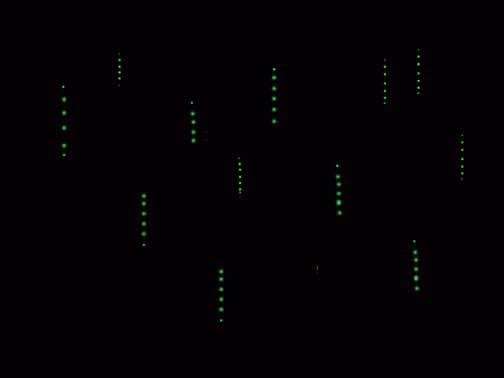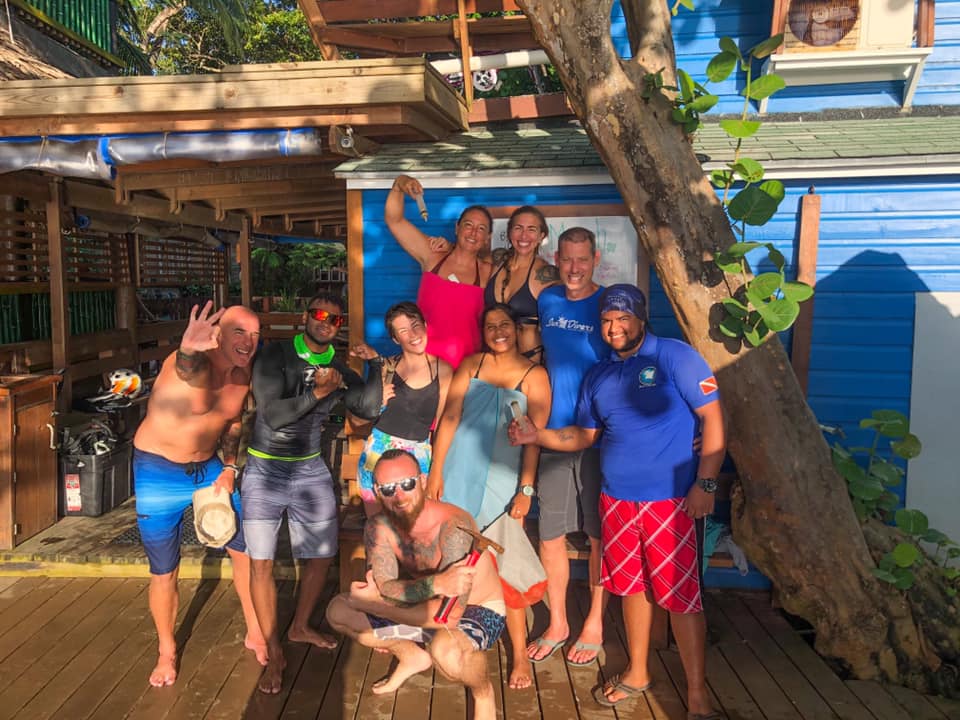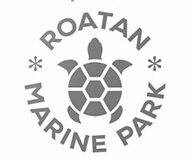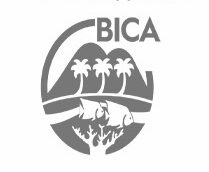By Author
Okay, so what is the String of Pearls?!
So you just finished your first Roatan night dive and experienced the globally rare “string of pearls” phenomena. The only thoughts that go through your mind are “have I entered the Matrix?” or “Who spiked my water?”.
Check out this cool TED Talk by bioluminescence specialist and Ocean Research and Conservation Association founder Edith Widder.
What you have seen can only be described as mind-altering and, possibly, life changing.
Imagine yourself in complete darkness. Each flurry of movement sends “sparks” through the water. The light gives you the sense of racing through the universe surrounded by a galaxy of stars. You are already amazed at the experience – THEN the magic happens – your eyes begin to focus on the strings of sparkling lines of brilliant green lights that flash in concert throughout the water.
So what is it that you’re exactly seeing?
The legend of the “String of Pearls” has a many homegrown explanations. The most common is simply that no one really knows what they are. While that isn’t completely true, sometimes the marvel of the experience is simply more romantic without knowing the details.
The truth of the matter is that there is real romance involved.
The real story behind the “String of Pearls” starts with a microscopic crustaceans
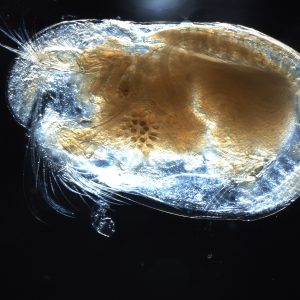
Ostracod
called Ostracods. These tiny creatures emerge from the depth about an hour after sunset to begin their bioluminescent courting ritual which consists of males excreting strings of “vomit” blobs of bioluminescent mucus – all in the name of love… And the Ostracod chicks dig it!
Each of the strings produce an intricate series of vertically progressing flashes to attract non-luminescent females of the same species. The displays typically consist of nine to 13 pulses, three bright, longer pulses followed by six to ten dimmer, quick pulses. The length of each train of displays is typically 50 to 70 centimeters with each pulse lasting a second or less and ranging from millimeters to centimeters apart.
Divers who experience this amazing sight often struggle to describe what they just experienced but are aware that what they witnessed was uniquely Roatan.
Now you’re asking yourself… how can I see the “String of Pearls”?
Every night dive will be a thrilling adventure but take a glance at the moon stages. If you happen to be on the island when there is a new moon (ie. No moon), your chances just increased dramatically. Check out more on our night diving at Sun Divers Roatan here.
SCTLD: Be part of the solution
We’re not the only ones on Earth trying to combat devastating diseases these days. The MesoAmerican Reef in the Caribbean has been facing its own pandemic caused by new disease called Stony Coral Tissue Loss disease.
Divers will ask us from time to time about the difference they are seeing in the coral. Many are sad to hear about the havoc this disease is wreaking on the reef system of their beloved Roatan and want to do something to help. Luckily, there is hope and divers can be a part of the solution.
So what exactly is Stony Coral Tissue Loss Disease?
The truth is that the scientific community is still working to understand exactly what SCTLD is. But, there is strong reason to believe that the disease is bacterial, based upon the efficacy of antibiotic treatments (more on these in a minute!).
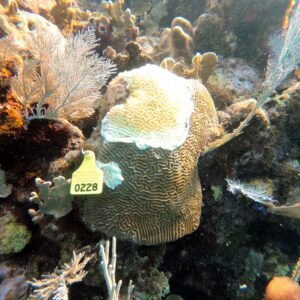
It effects over 24 types of stony corals. Iconic pillar corals, big and beautiful boulder brain corals and star and starlet corals being the most susceptible. The disease is characterized by freshly exposed white skeleton that usually forms in circular lesions, first appearing along the borders of coral colonies.
Do we know where it came from?
The disease first came on the radar in 2014 in Florida. That year there was a trifecta of incidences that wreaked havoc on the reef system there:
- 2014 was (and still is) the hottest year on record
- Coral colonies were getting hit hard with bleaching and
- the dredging of the Miami Port was badly damaging the reef. This trifecta made coral colonies weaker, less able to fight against diseases like SCTLD.
From Florida, the disease quickly spread across the Caribbean, ultimately making its way to Roatan in September of 2020.
Is there a cure?
There is still not a surefire way to stop SCTLD. However, antibiotics, specifically amoxycillin, have been proven to stop the progression of the disease. The amoxycillin in powder form is mixed with a special marine epoxy and then administered to coral colonies through syringes. Depending upon the coral species, the efficacy rate can range between 60-80%.
How do I help?
This all sounds catastrophic, but there is hope. And you’re part of it. Here’s how you can help:
- Decontaminate your gear. Pathogens can survive in scuba diving and snorkel gear. This can cause the disease to spread internationally. Help avoid this by soaking your gear in a solution of water with 1% bleach. Avoid further environmental contamination by allowing this solution to sit in the sun and breakdown for one day. Then dispose of it.
- Remember the 3 Ts: Don’t Touch, Take or Tease. Touching diseased coral and then healthy coral can cause transmission of the disease. But this isn’t the only reason you shouldn’t touch the coral. Coral are actually fragile animals. If you touch them, kick sand in them or hit them with your instruments, fins or body, you can seriously harm them. Learn more about Coral Etiquette from the NOAA.
- Volunteer for a Treatment Dive: At Sun Divers, one of our core values is to Always be Eco-Active. We believe that we’re not here just to enjoy the splendors of the ocean, but to protect them. One way we are acting as good stewards of the reefs, is conducting bi-weekly SCTLD treatment dives. Volunteer divers and local conservation agency staff from the Roatan Marine Park and Bay Islands Conservation agency, dive together to treat, tag, monitor and collect data on SCTLD. We have adopted two dive sites to focus and measure our efforts on: the beloved Blue Channel and Shallow Aquario.
- Snap a photo! You’re scouting the reef for you next perfect underwater photography shot and then you see it: a bright yellow tag with numbers on it. That is an identification tag for coral colonies treated for SCTLD. While not your intended subject, snapping a photo of the tagged coral colony and sending it to the Roatan Marine Park is a vital way that you can provide visual data for the monitoring of SCTLD.
- Support local conservation groups: In Roatan, SCTLD treatment efforts are being led by two non-profit organizations: The Roatan Marine Park and BICA. These organizations are authorized to purchase the marine epoxy used to administer the amoxycillin to corals and they do so through grant and private funding. Producing and shipping marine epoxy from Florida to Roatan can be quite expensive, so any amount of financial support helps. Learn more about how you can monetarily support SCTLD treatment through the RMP and BICA.


